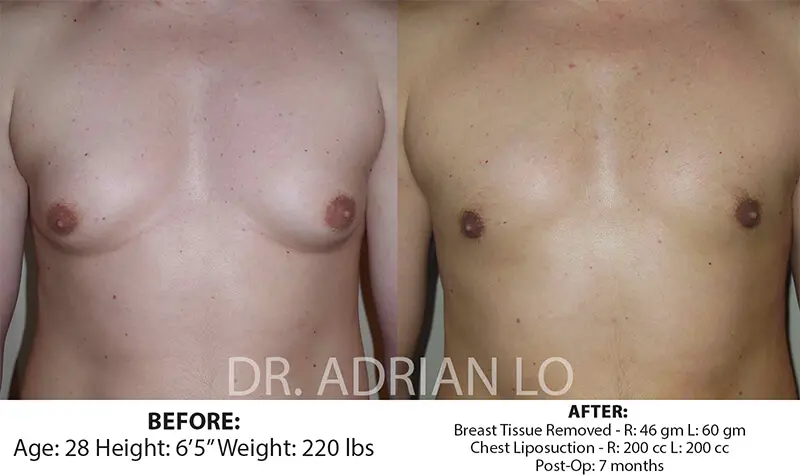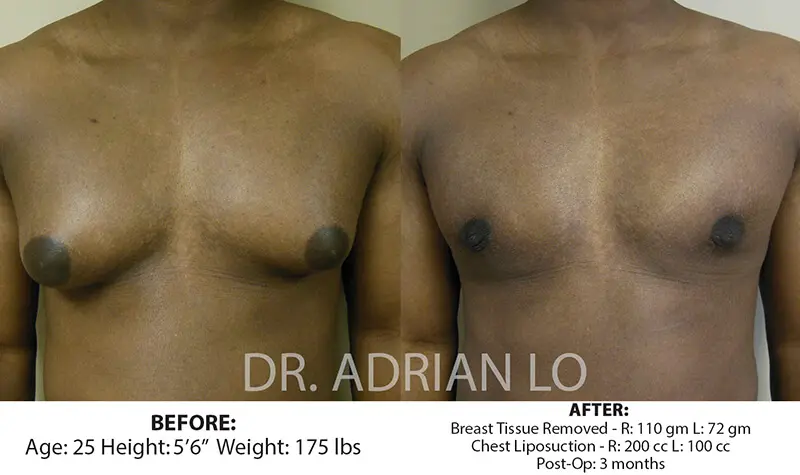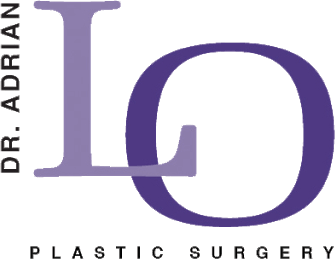Your chest shouldn’t hold you back. Yet for many men, enlarged breast tissue creates a daily battle with self-image, comfort, and confidence.
For those seeking treatment, understanding what male breast reduction is called and understanding what it can do can help one feel empowered and knowledgeable on their options to correct what bothers them about their chest. This procedure, medically termed gynecomastia surgery, removes excess breast tissue through surgical techniques. It restores a masculine chest contour when diet and exercise fail.
Men who undergo this treatment report dramatic improvements in self-confidence, physical comfort, and quality of life. The surgery addresses various causes of male breast enlargement, from hormonal imbalances to medication side effects.
Related: What Causes Gynecomastia?
What Is Male Breast Reduction Called
Understanding Gynecomastia

Gynecomastia refers to the enlargement of male breast tissue. According to Research Gate, this condition affects approximately 35% of men overall, with prevalence varying by age group. Studies show that 60-90% of newborns, up to 65% of adolescents, and 24-65% of men over age 50 may experience gynecomastia at some point in their lives.
While many cases resolve without intervention, persistent gynecomastia often requires medical attention, especially when diet and exercise does not help resolve the gynecomastia.
Male breast enlargement occurs due to an imbalance between estrogen and testosterone hormones. This imbalance can result from numerous factors, including:
- Hormonal changes during puberty or aging
- Certain medications, including some antibiotics and heart medications
- Anabolic steroid use
- Health conditions such as liver disease or hyperthyroidism
- Obesity, which increases estrogen production
Types of Male Chest Reduction Surgery
There are different surgical options for male breast reduction, also called gynecomastia surgery. Depending on your specific condition and the cause of your gynecomastia, a plastic surgeon will recommend the option that is best for your situation.
The primary surgical approaches to treat gynecomastia include:
Liposuction-Only Technique
For patients with primarily fatty tissue enlargement, liposuction offers an effective solution. This technique involves:
- Small incisions around the areola or in the natural chest creases or armpit
- Insertion of a cannula (thin tube) to break up and remove fatty tissue
- Minimal scarring and relatively quick recovery time
Removal of Gland Breast Tissue – Subcutaneous Mastectomy
When patients have significant glandular tissue, this tissue or glands must be removed through a technique called subcutaneous mastectomy. This approach involves surgical removal of the gland underneath the nipple and surrounding breast tissue through an incision around the lower edge of the nipple / areola.
Combination Approach
Most cases benefit from combining both liposuction and direct removal of gland breast tissue or subcutaneous mastectomy. This comprehensive approach addresses both fatty and glandular tissue components, providing optimal results for moderate to severe gynecomastia.
Removal of Excess Skin
When there is excess skin or the male breast is very large or droopy, then removal of skin from the chest may be required. This will be in combination with removal of the excess breast tissue. The nipple-areola complex will be repositioned, if necessary
Male Breast Reduction Candidates
Ideal candidates for gynecomastia surgery include men who:
- Have stable breast enlargement that has not responded to non-surgical treatments
- Maintain a relatively stable weight
- Do not use substances that may contribute to the condition
- Possesses good overall health
- Have realistic expectations about surgical outcomes
Men experiencing temporary gynecomastia due to medication use or temporary conditions may benefit from addressing the underlying cause before considering surgical intervention.
Gynecomastia Treatment Options
Non-Surgical Approaches
Before pursuing surgical intervention, patients may explore several non-surgical gynecomastia treatment options:
Lifestyle Modifications
For cases primarily caused by excess body fat, dietary changes and targeted exercise may reduce the appearance of enlarged breasts. These modifications include:
- A balanced diet focused on lean proteins and vegetables
- Reduction in processed foods and alcohol consumption
- Chest-specific exercises to build muscle and improve appearance
- Regular cardiovascular activity to reduce overall body fat
Medication Adjustments
When gynecomastia stems from medication side effects, consulting with a medical professional about alternative treatments may resolve the condition or prevent it from getting worse. Common medications that may cause gynecomastia include:
- Hair growth medications
- Anti-reflux medications
- Antidepressants
- Anti-anxiety medications
- Antibiotics
- Heart medications
- Prostate treatments
Hormone Therapy
In select cases, hormone therapy may help rebalance testosterone and estrogen levels. This approach works best for patients with confirmed hormonal imbalances and requires careful medical supervision. However, once one has established gynecomastia, restoring hormone balance will not reverse the gynecomastia.
Surgical Treatment Process
The male chest reduction surgery process involves several important stages:
Initial Consultation
The first appointment includes:
- Assessment of gynecomastia severity and cause
- Medical history review
- Medication review
- Discussion of goals
- Technique recommendations
- Explanation of risks and outcomes
Preoperative Preparation
Before surgery, patients must:
- Complete required laboratory tests if necessary
- Adjust medications as directed
- Stop smoking at least two weeks before surgery
- Follow fasting guidelines for surgery day
Surgical Procedure
The typical male chest reduction procedure:
- Takes 1 to 2 hours
- Uses general anesthesia or local with sedation
- Features strategic incision placement for minimal scarring
- Removes excess tissue (gland, fat, and sometimes skin)
- May require drainage tubes for larger procedures
Related: Is Gynecomastia Surgery Painful?
Recovery and Results
Male Breast Reduction Recovery Timeline

Male breast reduction recovery occurs in phases:
Immediate Postoperative Period (1 to 7 Days)
The first week includes:
- Wearing compression garments
- Managing discomfort with prescribed non-narcotic or OTC (such as Tylenol) medication
- Attending drain removal appointments (if needed)
- Beginning light walks
- Returning to desk work in 3 to 7 days
- Usually can return to driving in 2 to 3 days
Early Recovery (1 to 3 Weeks)
Weeks 1 to 3 typically involve:
- Continuing compression garment use
- Chest exercises starting at 2 weeks to shape the chest and tighten skin
- May exercise lower body and legs with no restriction
- Back to work in 1 to 2 weeks for physical occupations
Full Recovery (4 to 6 Weeks)
The final phase includes:
- Returning to more strenuous exercise
- Stopping compression garment use
- Adjusting to the new chest contour
- Incision lines continue to heal and fade
Complete healing may take 6 to 12 months as the chest continues to heal and the swelling resolves.
Expected Results and Satisfaction
Good candidates for gynecomastia surgery typically experience:
- Flatter, more masculine chest contour
- Better comfort in fitted clothing
- More confidence
- Less physical discomfort
- Long-lasting results with stable weight
Most men report significant quality of life improvements after successful surgery.
Potential Complications and Management
While gynecomastia surgery is generally safe, potential complications may include:
- Temporary or permanent changes in nipple sensation
- Asymmetry between breasts
- Contour irregularities
- Scarring that is more visible than anticipated
Working with a board-certified plastic surgeon specializing in gynecomastia surgery significantly reduces these risks. Following all preoperative and postoperative instructions also helps ensure optimal healing and results.
Practical Considerations
Gynecomastia Surgery Cost Factors
The cost of male breast reduction varies based on several factors:
Procedure Complexity
More extensive procedures involving both glandular excision and significant skin removal generally cost more than simpler liposuction-only approaches.
Geographic Location
Surgical fees vary considerably by region, with procedures in major metropolitan areas typically higher than those in smaller cities. Take a look at our patient financing options here!
Plastic Surgeon Expertise
Highly specialized plastic surgeons with extensive experience in gynecomastia surgery may charge premium rates that reflect their expertise and consistent results.
Facility and Anesthesia Fees
The surgical setting (hospital, ambulatory surgery center, or office-based surgical suite) and the type of anesthesia used influence the total cost.
Additional Services
Preoperative testing, postoperative garments, medications, and follow-up visits may or may not be included in the quoted surgical fee.
Most practices offer financing options to make gynecomastia surgery more accessible, as insurance rarely covers this procedure unless medical necessity can be demonstrated.
Selecting a Qualified Plastic Surgeon
The success of gynecomastia surgery can depend on the plastic surgeon’s skill and experience. Important qualifications include:
- Board certification in plastic surgery
- Specialized training in gynecomastia procedures
- Extensive experience with male breast reduction
- A portfolio of successful before-and-after results
- Clear communication about expectations and limitations
- Comprehensive approach to preoperative and postoperative care
Related: What Can Cause Man Boobs? From Hormones to Lifestyle Factors
Making an Informed Decision
Evaluating Gynecomastia Surgery Before and After Results

Reviewing before and after photographs helps patients understand potential outcomes. Look for:
- Cases with similar starting conditions
- Results from multiple angles
- Photos at different healing stages
- Understanding how body type affects results
- Scar placement and quality
Questions to Ask During Your Gynecomastia Surgery Consultation
Smart questions to ask include:
- Which technique works best for my case?
- How many gynecomastia surgeries do you perform yearly?
- Where will my scars be located?
- Will weight stability preserve my results?
- What complications might occur?
- How do you handle revisions if needed?
Psychological Benefits Beyond Physical Change
The psychological benefits of gynecomastia surgery often match or exceed the physical changes:
- Improved body image and self-perception
- Reduced anxiety in social situations
- Greater comfort during physical activities
- Expanded clothing options
- Enhanced confidence in intimate relationships
Transform Your Profile, Restore Your Confidence
Male breast reduction surgery provides a permanent solution when non-surgical approaches fail. Under the skilled care of a board-certified plastic surgeon, this procedure creates a more masculine chest contour while alleviating emotional distress.
Dr. Adrian Lo specializes in gynecomastia treatment, offering personalized care for men throughout Pennsylvania, New Jersey, and Delaware. With extensive experience in male chest reduction surgery, Dr. Lo combines surgical expertise with an understanding of the physical and emotional aspects of this condition.
Take the first step toward transformation by scheduling a consultation with Dr. Lo.
